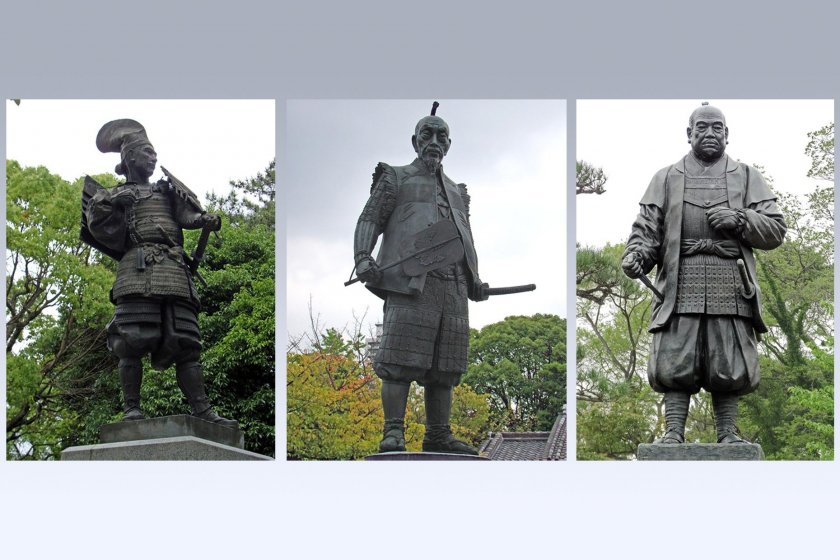From the turn of the 16th & 17th centuries, Japan was in a process of unification after centuries of constant inter-clan warfare. The most significant contributions to this unification were made by three personalities: Oda Nobunaga, Toyotomi Hideyoshi and Tokugawa Ieyasu. Castles connected with these men offer a direct link to Japan's turbulent history of unification.
Oda Nobunaga
Oda Nobunaga (1534-1582) was famous for his dedication, innovative ideas and ruthlessness towards his enemies. Many, however, considered him a despot, and may be the reason for the betrayal of his general Akechi Mitsuhide, which led to Nobunaga's death.
Gifu Castle, Nobunaga's main residence, is also where Japan's unification began. Founded in 1201, the castle acquired a close to modern appearance only by the 16th century. At that time, it was called 'Inabayama Castle'. On September 13, 1567, Nobunaga's troops besieged the castle – considered impregnable, it fell two weeks later. Oda Nobunaga renamed the castle and the entire province Gifu, making it his residence, from which he led military campaigns aimed at uniting Japan under his rule.
After Nobunaga's death and the Battle of Sekigahara in 1600, Gifu Castle was completely destroyed. It remained in this state until 1956 when it was restored according to historical drawings, but with significant modifications, for example, to make its foundation modern and stronger with reinforced concrete. The castle itself is small, but it is built on the highest point of the area; at a total height of 329 meters, Gifu Castle is one of the highest in Japan.
Toyotomi Hideyoshi
Oda Nobunaga was succeeded by Toyotomi Hideyoshi (1536-1598). Since Nobunaga was not a descendant of a noble family, he did not discriminate based on family line when it came to position within his government. Toyotomi Hideyoshi benefited from this. He first served as the wearer of Oda Nobunaga's sandals and had the nickname Saru - Monkey. However, his personal qualities allowed the common-born Hideyoshi to eventually become ruler of the country. He became famous not only for his military exploits, but also for his diplomacy.
Osaka Castle was built by Hideyoshi in 1585-1598. The most important trade routes converged in Osaka, and the castle and its adjacent territories became the center of the economic life of the country. With an area of 1 sq. km standing on a stone embankment and surrounded by a moat, Osaka Castle stood five stories above ground and three under it. Some 30,000 people were employed in its construction.
After Hideyoshi's death, the castle saw some tough times. A power struggle between Hideyoshi's heir and future ruler Tokugawa Ieyasu known as the Osaka Campaign ensued; in 1614, its moat was filled by besieging forces before falling a year later. In 1620, Ieyasu ordered it rebuilt larger, but in 1665, the main tower burned down after a lightning strike. In 1868 the castle fell to fire and anti-shogunate forces and after further restorations in 1931, was again damaged in the 1945 WWII bombing raids. The current castle was built in 1995-1997 and houses a modern museum while on the grounds sits Hokoku shrine, dedicated to Toyotomi Hideyoshi.
Another castle associated with Hideyoshi is Fushimi Castle, or Momoyama Castle, the reconstruction of which is located in Fushimi Kitabori Park, near Kyoto. The castle played an important role in the Battle of Sekigahara, but it suffered a lot. In 1602, it was restored by Tokugawa Ieyasu who held his ceremony of achieving the title of shogun there in 1603, becoming the shogun's headquarters in the process. However, the castle's status was reduced and in 1619 was dismantled and used to supply parts for other projects. The modern castle in Fushimi Kitabori Park, built in 1964, is a copy of the original. It provides a magnificent view from the park but visitors are not allowed inside.
Tokugawa Ieyasu
The final unification of Japan is associated with the name of Tokugawa Ieyasu. After his victory in the Battle of Sekigahara in 1600, and then later against the rival Toyotomi clan, the Tokugawa family came to power and ruled for the next 265 years (1603-1868). In 1868, the rule of the shogun ended and the samurai class was abolished. A new era in the history of Japan began.
Nagoya Castle was built in 1612 and though Ieyasu himself lived in Hamamatsu Castle for 17 years, Nagoya served as the main castle of the Tokugawa shogunate until 1868. Until the 1930s, the castle was under the control of the Japanese Empire, before being then transferred to Nagoya City. It was destroyed during WWII before being rebuilt with reinforced concrete in 1959 and now features a museum. Plans are underway to rebuild Nagoya Castle with original wood.
Another Tokugawa castle, Sumpu Castle, currently located in the city of Shizuoka, was built in 1585. Control passed of it hands before Ieyasu regained control of it afte winning the Battle of Sekigahara. From the castle, Tokugawa ruled Japan 'from behind the scenes'. Sumpu Castle suffered from fire many times and after the fire of 1635, only the palace and the gate were restored. In 1949 the grounds were turned into a city park.

























